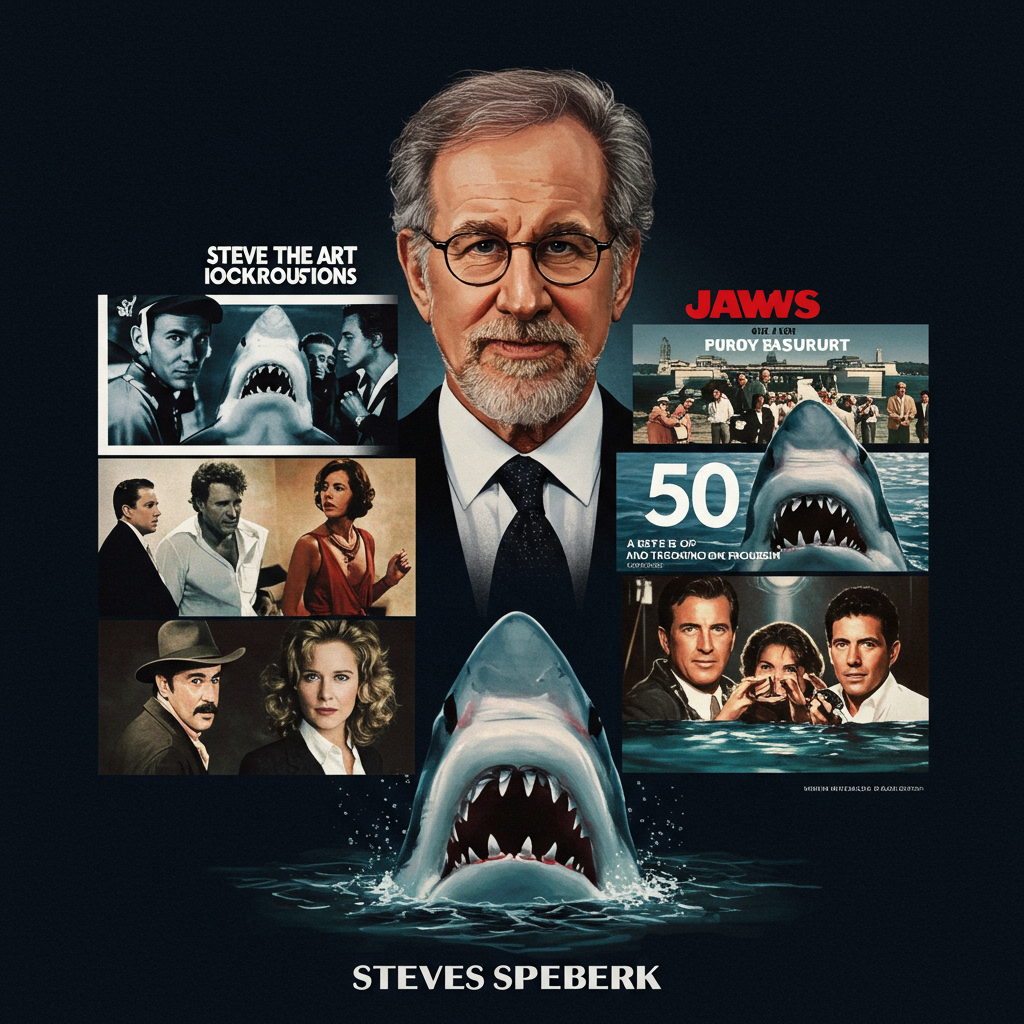Fifty years ago, Steven Spielberg’s Jaws unleashed a terrifying great white shark on unsuspecting moviegoers, but it did far more than just make people afraid to go back in the water. This groundbreaking film, released in June 1975, didn’t just redefine the creature feature; it engineered a narrative and marketing template that Hollywood would replicate for decades, birthing the modern summer blockbuster as we know it.
Long before Jaws, monster movies existed, from the countless Godzilla films to Universal’s classic horrors like Creature from the Black Lagoon. Spielberg himself drew inspiration from B-movie producer Roger Corman and suspense master Alfred Hitchcock. However, Jaws achieved unparalleled success thanks to a significant budget, a wide theatrical release strategy that was revolutionary for the time, and crucially, a tightly structured, deeply effective narrative. Its influence is so pervasive that even if you haven’t seen the film, its blueprint is likely familiar from countless others.
To understand just how deeply Jaws embedded itself into Hollywood’s DNA, film analysts have dissected its structure, identifying nine key plot points that form its repeatable playbook. This core formula balances suspense and spectacle while keeping the human stakes firmly in focus. An analysis of over 50 films released since 1975 reveals how widely this template has been adopted, sometimes as direct homage or even knock-off (like 1982’s Great White, which faced copyright claims), and sometimes adapted to entirely different genres, famously inspiring the pitch for Alien (1979) as “‘Jaws’ in space.” Even recent hits like Jordan Peele’s Nope (2022) show clear traces of the Jaws formula.
Here is a breakdown of the nine elements that make up the iconic Jaws template:
1. The Creature
The antagonist in a “Jaws” template film is typically a formidable, often non-human threat. While Jaws gave us a great white shark, this role can be filled by almost anything – grizzly bears, aliens, dinosaurs, snakes, carnivorous worms, or even non-biological forces like tornadoes (Twister, 1996) or a viral outbreak (Contagion, 2011). The variety is vast, from aquatic terrors like octopuses and piranhas to land-based monsters like wild boar and the subterranean Graboids from Tremors.
A key technique inherited from Jaws is the initial withholding of the creature. In Jaws, this was partly born out of necessity – the film’s mechanical shark, nicknamed “Bruce” after Spielberg’s lawyer, was notoriously unreliable on set. Visual effects supervisor Dennis Muren noted that fewer shark shots than planned ultimately helped the film. Film critic Matt Singer points out that “Not showing the shark means the shark is forever the creature in our minds,” arguing that the audience’s imagination can conjure far greater horrors than any special effect, no matter how advanced. Like the T. rex in Jurassic Park (1993), we hear and feel the creature’s presence long before we see it fully. When the creature is shown, screen time is often minimal, maximizing impact.
2. The Remote Location
Isolation is paramount for suspense. The setting in these films severely limits characters’ ability to escape or call for outside help. Amity Island, and later the open ocean in Jaws, are prime examples. This isolation principle is echoed in films set aboard spaceships (Alien, 1979), frozen landscapes (The Thing, 1982), vast wildernesses (Razorback, 1984; The Ghost and the Darkness, 1996), or even just a small boat or flooded basement (Open Water, 2003; The Shallows, 2016; Crawl, 2019). The location itself becomes a character that amplifies the threat.
3. The First Victim
An early, often anonymous death is a classic horror trope used to immediately establish the creature’s deadly capability without giving too much away. In Jaws, it’s the young woman skinny-dipping at dusk. Filmmaker John Sayles (Piranha, Alligator) observes that these initial victims are often “marginal people” the audience hasn’t yet formed a connection with. Their gruesome demise, like the remains washing ashore in Jaws or the victim found atop a telephone pole in Tremors (1990), sets the terrifying stakes.
4. The Reluctant Hero
Someone must eventually step up to face the danger, and this is often someone who initially doesn’t want the responsibility. Police Chief Brody in Jaws embodies this archetype – an outsider on the island, afraid of the water, yet morally compelled to act. Film critic Amy Nicholson describes this character as “the only person who sees the problem clearly,” someone initially dismissed but ultimately essential. These heroes are frequently parents or caretakers (Brody has children; the hero in The Host (2006) risks everything for his daughter), making the threat personal. Their fear, like Brody’s open anxiety (often leading him to heavy drinking), paradoxically makes them more alert to the danger.
5. The Local Authority
Often standing in the hero’s way is a figure of local power who prioritizes other concerns – typically economics or reputation – over public safety. Mayor Vaughn in Jaws, determined to keep the beaches open despite the shark attacks, is the definitive example. These characters represent the human obstacles in the story, driven by greed, arrogance, or moral indifference. They often dismiss the hero’s warnings and, in some films like Great White or Anaconda (1997), meet a fittingly spectacular end at the hands of the creature they underestimated.
6. The Experts
Since the reluctant hero is rarely equipped to handle the threat alone, they must enlist help from experts. This often leads to uneasy alliances with specialists who possess crucial knowledge but may clash with the hero or each other. In Jaws, Brody forms a tense trio with the pragmatic oceanographer Hooper and the grizzled, hard-drinking fisherman Quint. These experts, whether scientists, hunters, or survivalists, bring necessary skills but are sometimes too specialized or reckless to survive the ordeal themselves, frequently becoming later victims.
7. The Sacrifice
Beyond the initial victims, a later death serves to dramatically raise the stakes and emphasize the creature’s unstoppable nature. This “sacrifice” typically occurs with a character the audience has come to know and care about, making it hit harder than the anonymous first kill. Quint’s death in Jaws, after endearing himself through his stories and banter, is a prime example. John Sayles noted a victim hierarchy in creature films, starting with “marginal people” before moving to more central characters or communities. To keep audiences off guard, some films like Deep Blue Sea (1999) have even shocked viewers by killing off a prominent character unexpectedly early.
8. The Confrontation
The narrative builds to a final showdown between the reluctant hero and the creature. This climax is often the first time the creature is fully revealed in all its terrifying glory. In Jaws, the epic battle takes place on the rapidly sinking boat Orca, forcing Brody to use the tools left by his fallen or absent allies. These confrontations can be drawn out, pushing the hero to their limits and requiring ingenuity, as seen in films like The Shallows (2016) or Crawl (2019) where characters are trapped with the predator.
9. The Creature’s Death
The payoff moment the audience has eagerly anticipated often involves a spectacular, reality-bending demise for the creature. Spielberg famously wanted a “big rousing ending,” diverging from Peter Benchley’s novel where the shark simply dies of exhaustion. He believed that after two hours of carefully built tension, viewers would accept a moment of pure spectacle. The iconic Jaws ending – Brody shooting the oxygen tank in the shark’s mouth, causing it to explode in a rain of blood and viscera – became massively influential. This improbable, explosive death is replicated in numerous films, from Tremors (1990) where a worm swallows a pipe bomb, to Spielberg’s own War of the Worlds (2005) and Jordan Peele’s Nope (2022), where extraterrestrial threats similarly meet explosive ends after ingesting something they shouldn’t. Writer David Koepp, who penned Jurassic Park and War of the Worlds, noted the pressure to deliver a “Jaws” like conclusion when writing for Spielberg.
Beyond the Blueprint: Marketing, Production, and Legacy
Jaws‘s impact extends beyond its plot structure. The film was a pioneer in modern marketing, spending an unprecedented $700,000 on prime-time television ads alone, a strategy now standard for major releases. Combined with talk show appearances, merchandise tie-ins, and pushing Peter Benchley’s bestselling novel, Universal generated massive pre-release hype. Its box office performance was revolutionary; costing under $9 million, it grossed over $470 million globally, becoming the first film to exceed $100 million domestically and the highest-grossing film of its time. Adjusted for inflation, it remains one of the top-grossing films ever. This proved that a film could be a high-quality, critically praised work (it was nominated for Best Picture and won three Oscars) and a mass-market phenomenon, establishing the model for the high-concept summer “tentpole” feature.
Spielberg’s journey to directing Jaws was itself a product of persistence and honing his craft through early amateur films (Firelight, Amblin’) and television work (Night Gallery, Columbo), culminating in the suspenseful TV movie Duel (1971). Duel‘s Hitchcockian tension and use of wide frames previewed techniques he’d use to great effect in Jaws. The notoriously difficult production of Jaws, plagued by mechanical shark issues and filming challenges on the open ocean, forced Spielberg to innovate, leading to the suspenseful “less-is-more” approach that became a hallmark.
However, Jaws‘s legacy isn’t without its shadows. The intense public fear it generated contributed significantly to a dramatic decline in large shark populations along the East Coast, a consequence both Spielberg and Benchley later expressed regret over. Benchley became a vocal shark conservationist, stating increased knowledge would prevent him from writing the novel today.
Fifty years on, while Jaws spawned mediocre sequels and countless imitations, its original brilliance endures. Its nine-point template continues to resurface across genres, proving the power of its foundational structure. Contemporary films still grapple with its legacy, with some, like the recent thriller Dangerous Animals, attempting to subvert the formula by shifting the monstrous focus from the shark to a human villain who weaponizes the animal, exploring themes of voyeurism and complicity in a post-Jaws world. Jaws didn’t just scare a generation; it provided Hollywood with a blueprint for capturing audience attention, setting the stage for the blockbusters that dominate cinema to this day.


